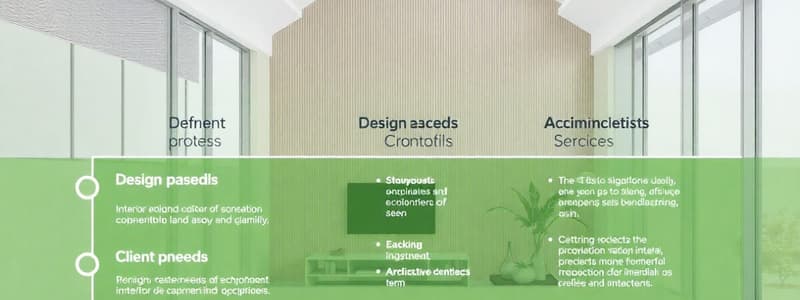Podcast
Questions and Answers
What is the primary focus of Phase 1 in the design process?
What is the primary focus of Phase 1 in the design process?
- Evaluating client feedback
- Documenting specific work details (correct)
- Obtaining bids from contractors
- Installation of design elements
During which phase are bids obtained and contractors selected?
During which phase are bids obtained and contractors selected?
- Phase 2 (correct)
- Phase 1
- Phase 4
- Phase 3
What is included in the details documented during Phase 4?
What is included in the details documented during Phase 4?
- Design evaluation
- Client move-in schedule
- Installation confirmation
- Lighting plans and fixture selection (correct)
Which phase is described as the final stage where designs are built and installed?
Which phase is described as the final stage where designs are built and installed?
What happens in Phase 6 of the design process?
What happens in Phase 6 of the design process?
Which phase focuses on ensuring that installation is done correctly and documents are followed?
Which phase focuses on ensuring that installation is done correctly and documents are followed?
What is the significance of the design process in the Interior Design profession?
What is the significance of the design process in the Interior Design profession?
Which phase is characterized by the issuance of purchase orders?
Which phase is characterized by the issuance of purchase orders?
What is the primary focus during the pre-design phase of the design process?
What is the primary focus during the pre-design phase of the design process?
What occurs after the pre-design phase if the designer's skills align with the client's needs?
What occurs after the pre-design phase if the designer's skills align with the client's needs?
Which of the following activities is included in the programming phase?
Which of the following activities is included in the programming phase?
What is the main purpose of the schematic design phase?
What is the main purpose of the schematic design phase?
What happens during the design development phase?
What happens during the design development phase?
What is one of the key elements considered during the schematic design phase?
What is one of the key elements considered during the schematic design phase?
Which of the following is NOT part of the programming phase?
Which of the following is NOT part of the programming phase?
What is the outcome of the design development phase?
What is the outcome of the design development phase?
Flashcards
Programming Phase
Programming Phase
The initial phase of the design process where the project's goals, needs, and requirements are determined.
Schematic Design
Schematic Design
This step involves developing a preliminary design concept, including layout, space organization, and initial design elements.
Design Development
Design Development
Here, the design is refined, and the details are fleshed out, including material selections, furniture layouts, and construction drawings.
Contract Documents
Contract Documents
Signup and view all the flashcards
Contract Administration
Contract Administration
Signup and view all the flashcards
Move-in & Post Occupancy
Move-in & Post Occupancy
Signup and view all the flashcards
The Design Process
The Design Process
Signup and view all the flashcards
The Design Process
The Design Process
Signup and view all the flashcards
Pre-design Interview
Pre-design Interview
Signup and view all the flashcards
Programming
Programming
Signup and view all the flashcards
Space Planning
Space Planning
Signup and view all the flashcards
Elevations
Elevations
Signup and view all the flashcards
Floor Plans
Floor Plans
Signup and view all the flashcards
Design Implementation
Design Implementation
Signup and view all the flashcards
Study Notes
The Design Process
- The design process is a crucial tool for interior designers and architects
- It's about creating real solutions for client needs, rather than just reflecting the designer's personal taste.
- The process involves several phases, starting with pre-design and progressing through programming, schematic design, design development, contract documentation, construction administration, and finally, move-in and post-occupancy.
Pre-design Phase
- Designers interview clients to understand their needs.
- If the designer's skills match and the client agrees, a contract is signed, and the formal interior design process begins; otherwise, they part ways.
Phase 1: Programming
- This phase focuses on understanding the client's situation and needs.
- Questions about the space's function, who will use it, and furniture/equipment requirements are addressed.
- Measurements and photos are taken.
Phase 2: Schematic Design
- Space planning and furniture layouts are developed in this phase.
- Circulation patterns and minimum clearances are considered.
- Rough sketches and elevations are created.
- Preliminary furniture and finish ideas are presented to the client for review and revision.
Phase 3: Design Development
- Once the schematic design is finalized, detailed floor plans and elevations are produced.
- Colors, finishes, furniture, fabrics, and equipment are selected, and cost estimates are prepared.
- The final design is presented to the client for review, revision, and final approval.
Phase 4: Contract Documents
- Specific details of the work, including millwork specifications, finish selections, lighting plans, and fixture selections, are all documented.
- Plumbing and electrical layouts are detailed in the plan.
- This phase involves obtaining bids, selecting contractors, and issuing purchase orders.
Phase 5: Contract Administration
- This is the final stage where things are built and installed
- Designers are often onsite during installation to ensure quality, proper installation, and adherence to the documents.
Phase 6: Move-in & Post-Occupancy
- Clients schedule a move-in date.
- They are also asked to evaluate the design process and provide feedback.
Final Thoughts
- This entire process is invaluable to interior design and interior architecture professions.
- Designers should focus on real client needs, rather than personal taste or preferences.
- The continuous feedback and iteration throughout the design process ensures that the solutions meet the clients' real needs.
Studying That Suits You
Use AI to generate personalized quizzes and flashcards to suit your learning preferences.
Related Documents
Description
Explore the various phases of the design process crucial for interior designers and architects. This quiz covers pre-design, programming, schematic design, and more, emphasizing client needs and practical solutions. Test your understanding of each phase and its importance in creating effective design solutions.




